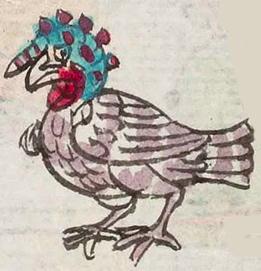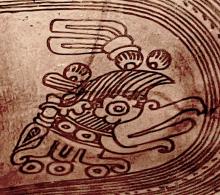huexolotl (Mdz13r)
This simplex glyph for the turkey hen (huexolotl) also represents the place name, Huexolotlan. The whole bird is shown, facing to our left, with lavender and white feathers on most of its body, except the head. The head is largely turquoise, with red bumps along the crest and sides of the head. Its neck is red. Above the beak is a fleshy, turquoise and red-striped protrusion. The beak is closed.
Stephanie Wood
The huexolotl was a tribute item. The bird also had associations with Tetzcatlipoca and other divinities. The turkey hen could be called totolin or cihuatotolin. Alexander von Humboldt wrote: "New Spain has supplied Europe with the largest and most useful of domestic gallinaceous birds, the turkey (totolin or huexolotl) which was formerly found wild on the back of the Cordilleras, from the Isthmus of Panama to New England" (Political Essay on the Kingdom of New Spain, vol. 3, p. 55, of 1811).
Compare the red and turquoise details of the head of this turkey cock with this open-source photograph. When we think about how these colors were valued in Aztec culture, we can understand the attraction to this bird, not to mention for its food value.
Stephanie Wood
c. 1541, but by 1553 at the latest
Stephanie Wood
huehxolotl, vesulotl, uexolotl, turkeys, turkey cock, turkey cocks, gallipavo, aves de corral, birds, guajolotes, fowl, feathers, plumas
huexolotl. Detail of a decoration on a pottery brazier braserillo, Museo Nacional de Antropología e Historia, Salón Mexica. Photograph by Robert Haskett, 14 February 2023.

huexolo(tl), turkey hen, https://nahuatl.wired-humanities.org/content/huexolotl
turkey
el guajolote, el pavo
Stephanie Wood
Codex Mendoza, folio 13 recto, https://digital.bodleian.ox.ac.uk/objects/2fea788e-2aa2-4f08-b6d9-648c00..., image 36 of 188.
The Bodleian Libraries, University of Oxford, hold the original manuscript, the MS. Arch. Selden. A. 1. This image is published here under the UK Creative Commons, “Attribution-NonCommercial-ShareAlike 3.0 License” (CC-BY-NC-SA 3.0).
huehxōlōtl (Karttunen, 1992, 85)




